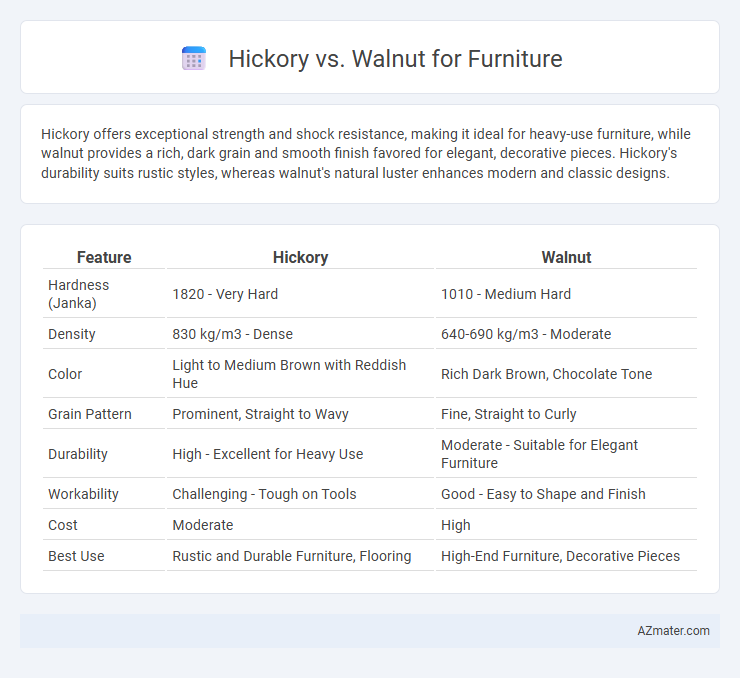Hickory offers exceptional strength and shock resistance, making it ideal for heavy-use furniture, while walnut provides a rich, dark grain and smooth finish favored for elegant, decorative pieces. Hickory's durability suits rustic styles, whereas walnut's natural luster enhances modern and classic designs.
Table of Comparison
| Feature | Hickory | Walnut |
|---|---|---|
| Hardness (Janka) | 1820 - Very Hard | 1010 - Medium Hard |
| Density | 830 kg/m3 - Dense | 640-690 kg/m3 - Moderate |
| Color | Light to Medium Brown with Reddish Hue | Rich Dark Brown, Chocolate Tone |
| Grain Pattern | Prominent, Straight to Wavy | Fine, Straight to Curly |
| Durability | High - Excellent for Heavy Use | Moderate - Suitable for Elegant Furniture |
| Workability | Challenging - Tough on Tools | Good - Easy to Shape and Finish |
| Cost | Moderate | High |
| Best Use | Rustic and Durable Furniture, Flooring | High-End Furniture, Decorative Pieces |
Introduction to Hickory and Walnut Furniture
Hickory furniture is known for its exceptional strength, durability, and striking grain patterns, making it ideal for rustic and farmhouse-style pieces. Walnut furniture offers rich, deep color tones and smooth texture, prized for elegant and high-end designs. Both hardwoods provide longevity and unique aesthetic appeal, with hickory emphasizing toughness and walnut highlighting luxury.
Appearance and Grain Patterns
Hickory furniture showcases a distinctive, bold grain pattern with contrasting light and dark streaks, offering a rugged and rustic aesthetic ideal for casual or country-style interiors. Walnut features a smoother, more uniform grain with rich, deep chocolate brown hues that darken over time, lending a sophisticated and elegant look to furniture pieces. The choice between hickory and walnut depends on whether the desired appearance emphasizes dramatic texture and contrast or refined, consistent warmth in the wood grain.
Hardness and Durability Comparison
Hickory has a Janka hardness rating of approximately 1,820, making it one of the hardest and most durable domestic hardwoods, ideal for furniture subjected to heavy use. Walnut, with a Janka hardness of around 1,010, is softer but offers excellent resistance to wear while providing rich color and grain patterns. For furniture that demands superior toughness and impact resistance, hickory outperforms walnut, although walnut excels in aesthetic appeal and moderate durability.
Workability and Ease of Crafting
Hickory offers exceptional workability with its dense grain that holds screws and nails firmly, making it ideal for sturdy furniture requiring durability. Walnut is prized for its smooth texture and consistency, allowing intricate carving and easy sanding that results in refined, elegant pieces. Both woods respond well to hand and machine tools, but walnut's lower hardness makes it easier to shape and finish compared to the tougher, more resilient hickory.
Cost and Availability
Hickory furniture tends to be more affordable and widely available due to its abundance and fast growth rate, making it a cost-effective choice for durable pieces. Walnut, known for its rich color and fine grain, commands higher prices and is less readily available because of slower growth and limited supply. The price difference between hickory and walnut can significantly impact budget considerations for furniture projects.
Finishing and Stain Options
Hickory offers a wide range of finishing options due to its open grain, absorbing stains evenly and showcasing its natural variation from creamy white to reddish-brown. Walnut's dense, fine grain provides a smooth surface ideal for clear finishes and darker stains, highlighting its rich chocolate and purplish hues. Both woods respond well to oil, lacquer, and polyurethane finishes, with hickory favoring rustic, textured looks while walnut emphasizes elegant, polished appearances.
Maintenance and Longevity
Hickory furniture offers exceptional durability and resistance to dents, requiring minimal maintenance with occasional polishing and cleaning to preserve its rugged finish. Walnut, prized for its rich color and fine grain, demands more careful upkeep, including regular dusting and protection from prolonged sunlight to prevent fading and maintain its polished appearance. Both woods provide long-lasting furniture solutions, but hickory's toughness makes it ideal for high-traffic areas, while walnut delivers enduring elegance with moderate maintenance.
Sustainability and Environmental Impact
Hickory furniture is often praised for its rapid growth rate and renewable harvesting potential, making it a more sustainable choice compared to walnut, which grows slower and requires longer maturation periods. Walnut wood, though durable and aesthetically appealing, has a higher environmental impact due to its slower growth and preference for specific climates, leading to less sustainable forestry practices. Selecting hickory supports responsible forest management and reduces carbon footprint associated with furniture production.
Best Uses for Each Wood Type
Hickory is ideal for furniture requiring exceptional strength and durability, such as rustic dining tables, cabinets, and flooring, due to its high density and shock resistance. Walnut offers a rich, dark finish perfect for elegant bedroom sets, desks, and fine cabinetry, excelling in applications where aesthetic appeal and smooth workability are prioritized. Both woods perform well in high-traffic areas, but hickory's toughness suits heavy-use environments, while walnut's stability and luxurious grain patterns enhance decorative pieces.
Final Verdict: Choosing Between Hickory and Walnut
Hickory offers exceptional durability and a rustic, light-to-medium tone ideal for high-traffic furniture, while walnut provides a rich, dark finish and smooth grain suited for elegant, statement pieces. When prioritizing strength and a more casual look, hickory stands out as the preferred option; walnut excels in luxury and a refined aesthetic. Final selection hinges on balancing durability needs with design preferences and budget constraints for lasting satisfaction.

Infographic: Hickory vs Walnut for Furniture
 azmater.com
azmater.com